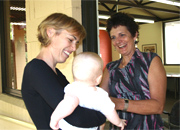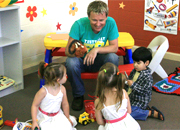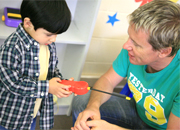Behaviour
Caring for babies
Bottle feeding
Changing a nappy
Cleaning and sterilising bottles
Daily cleaning tasks
Helping new children settle in
Preparing for a nappy change
Sleep patterns – babies
Sleep routines – babies
Toilet training
Caring for children
Allowing time for practice
Dressing/undressing
Mealtimes
Nappy change
Packing away/caring for the environment
Sleep/rest time
Toileting
Common self-help milestones
Tips for sleep and rest time
Self image
Communication
Body language
Limits and guidelines
Ways children communicate
Greeting children and families
Modelling appropriate communication
Questioning
Verbal and non–verbal communication
Acknowledging children's feelings
Listening attentively
Communicating with Aboriginal and Torres Strait Islander parents/carers
Development
Allowing time for practice
Dressing/undressing
Mealtimes
Nappy change
Packing away/caring for the environment
Sleep/rest time
Toileting
Common self-help milestones
Creative development
Language development
Modelling positive relationships
Physical development
Sharing and taking turns
Sleep patterns – babies
Sleep routines – babies
Encourage independent problem solving
Fundamental movement skills
Health, hygiene and safety
Coping with stress
Correct manual handling principles
Daily cleaning tasks
Hand washing
Hand washing poster
Manual handling overview
Toilet training
Safety checklist
Learning experiences and play
Environmentally friendly learning experiences
Learning experiences for different development areas
Creative resource materials
Arranging the environment to facilitate learning and pleasure
Indoors and outdoor areas
Creating a positive physical environment
Legal and ethical issues
Child abuse case studies
How do I recognise when a child or young person is at risk?
Tips on dealing with disclosures
Observation methods
Arranging Experiences (PDF 351Kb)
Recording observations
Rules for making observations
What you can learn from observations
Programming
Children’s interests, strengths, needs and skills
Extending the children’s interest in dinosaurs
Objective observation
Planning an OSHC environment
Behavior management plan
Planning enjoyable experiences
Planning experiences for 0 - 2 years age group
Planning experiences for 2 - 3 years age group
Planning experiences for 3 - 5 years age group
Modelling positive relationships
Everything you say and do when you're around children can impact on their perception of appropriate behaviour and ways of expressing feelings.
The key is to promote the formation of positive relationships. There are many ways to do this, including communicating with respect and sincerity, and providing activities to encourage positive interaction.
It is far easier to guide a child positively, than have to implement behaviour management strategies after an issue arises. Remember, prevention is better than cure!
Respect and sincerity

Respect and sincerity are key elements in any communication you undertake.
As a caregiver you are required to role model these skills constantly. By doing this you will demonstrate to the children in your care that this is the appropriate way to behave. You can demonstrate this by being respectful and sincere with the children, their families and your colleagues.
Experiences

Experiences will provide you with many opportunities to promote the formation of positive relationships.
You can do one-on-one experiences or group experiences. You can use puppets or tell stories with directed meanings. Positive experiences can be used in many different ways.
Individual communication

Individual communication can take place through planned experiences or spontaneously.
This can involve talking with the child about how they are feeling, helping them to express feelings, and helping with what words to use. It could also mean talking with all the children individually about considering others and being respectful of their play. For example, explaining the importance of asking for a toy rather than just taking it from another child.